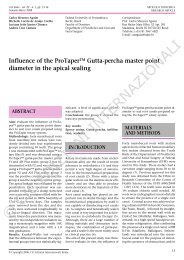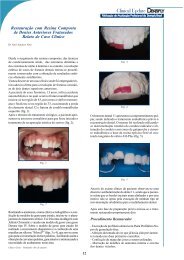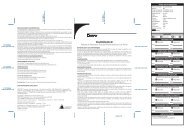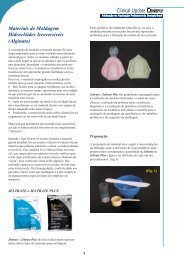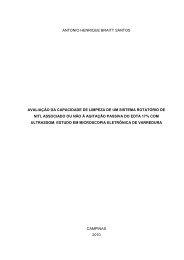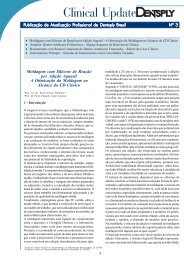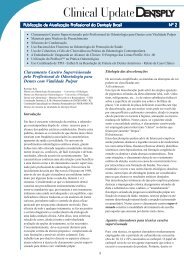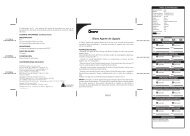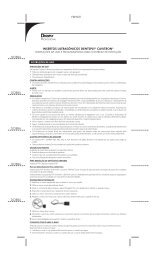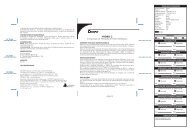Create successful ePaper yourself
Turn your PDF publications into a flip-book with our unique Google optimized e-Paper software.
Ferrari et al<br />
Table 2 Performance criteria according to Ryge<br />
Criteria and number of XP Bond<br />
restorations evaluated after SCA alpha bravo charlie delta<br />
6 months Calibra[n]<br />
Marginal discoloration and 53 53 0 0 0<br />
integrity<br />
Secondary caries 53 53 0 0 0<br />
Vitality test 53 53 0 0 0<br />
Interproximal contacts 53 53 0 0 0<br />
Retention 53 53 0 0 0<br />
Fracture 53 53 0 0 0<br />
sprayed and air dried carefully. 36% phosphoric acid gel was<br />
then applied for 15 s on enamel margins, and then for other<br />
15 s on dentin. The gel was removed with air spray and<br />
the surface blown gently with an air syringe. One drop of XP<br />
Bond was dispensed and mixed with one drop of self-curing<br />
activator. Using a microbrush, all cavity walls were wet and<br />
the adhesive material was left undisturbed for 20 s. After<br />
that, the solvent was evaporated by thoroughly blowing with<br />
air from an air syringe for 5 s. No light curing step was performed.<br />
Calibra Esthetic Resin Cement base and catalyst in<br />
similar amounts were mixed and applied on the cavity surface.<br />
Then the restoration was placed in the cavity preparation,<br />
and resin cement excess was removed with a clean microbrush.<br />
The Calibra cement was used in self-curing mode.<br />
The restorations were placed in March and April 2006 and<br />
examined for postoperative sensitivity at baseline, after 2<br />
weeks and 6 months by the same operator. At each recall,<br />
data on postoperative sensitivity, stability, and longevity<br />
were collected with reference to the USPHS criteria. Therefore,<br />
the following parameters were assessed:<br />
• postoperative sensitivity with the restoration under function,<br />
cold and warm stimuli, and a gentle air stream (on a<br />
scale from 0 to 10).<br />
• marginal discoloration and integrity<br />
• secondary caries<br />
• fracture<br />
• vitality test<br />
• retention<br />
• interproximal contacts<br />
The null hypothesis was that the self-curing mode does<br />
not affect postoperative sensitivity.<br />
RESULTS<br />
The results of postoperative sensitivities are summarized in<br />
Table 1. All 53 teeth were evaluated at baseline, and after 2<br />
weeks and 6 months. At baseline, 3 patients showed pre-operative<br />
sensitivity on 5 teeth. Ten cases of postoperative sensitivity<br />
were observed at the 2-week recall, but only 3 after<br />
6 months. At the 2-week recall, the postoperative sensitivity<br />
increased from 0 to 6 in one case immediately after luting<br />
the restoration (after the anesthetic wore off) but<br />
dropped to score 3 after 6 months. In 7 cases showing an<br />
increase in postoperative sensitivity after 2 weeks, the hypersensitivity<br />
disappeared completely after 6 months. In<br />
two cases, a residual postoperative sensitivity of score 2 remained<br />
after 6 months. No adverse events/effects occurred.<br />
All other parameters showed alpha scores (Table 2).<br />
DISCUSSION<br />
Ceramic crowns can be considered a safe type of restoration,<br />
and are reported to last longer than any other esthetic indirect<br />
restoration, 15 although many factors influence success,<br />
such as the kind of ceramic, luting agent, and extension of<br />
the lesion. Notwithstanding the restoration material, debonding<br />
and thus microleakage at the gingival margins – particularly<br />
if located below the cementoenamel junction – cannot<br />
be completely prevented. 1,8 All these factors are related to<br />
three subjects: patient, dentist, and material. 11<br />
In order to control for any additional source of variation besides<br />
the patient-related variability, one and the same operator<br />
placed all the restorations in this clinical trial. Inclusion<br />
and exclusion criteria were followed in order to obtain the<br />
Ethics Committee’s approval. The occurrence of postopera-<br />
Vol 9, Supplement 2, 2007 281



